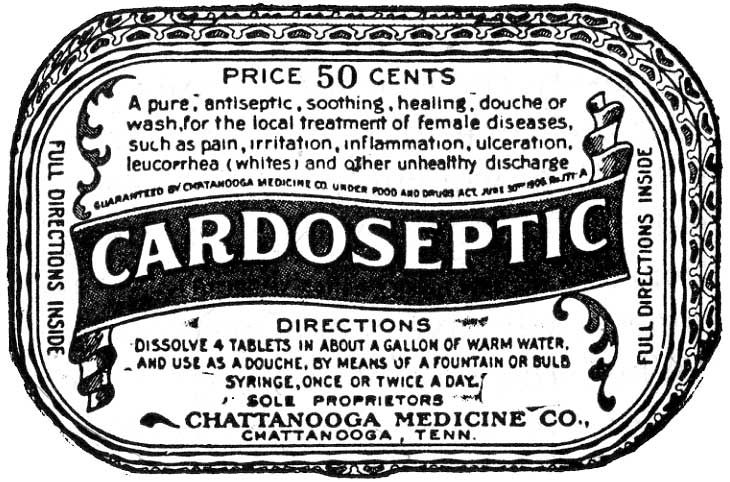See Dr. Grace Feder Thompson's letter
appealing for patients, Dr. Pierce's
medical empire and Lydia
E. Pinkham's Vegetable Compound


|

"Home
Treatment for Women,"
(aka "CARDUI Home
Treatment of Female Diseases"),
before 1920?
Chattanooga Medicine Company,
U.S.A.
Complete booklet, 64 pages plus
covers
The text of the illustration
(see bottom of this page)
includes "Guaranteed
by Chattanooga Medicine Co.
under Food and Drugs [sic?]
Act[,] June 30th 1906 .
. . ." Wikipedia writes this
(http://en.wikipedia.org/wiki/Pure_Food_and_Drug_Act):
The Pure Food and Drug Act
of June 30, 1906 is a United
States federal law that provided
federal inspection of meat
products and forbade the
manufacture, sale, or
transportation of adulterated
food products and poisonous
patent medicines. The Act arose
due to public education and
exposées from authors
such as Upton Sinclair and
Samuel Hopkins Adams, social
activist Florence Kelley,
researcher Harvey W. Wiley, and
President Theodore Roosevelt.
Though the Pure Food and Drug
Act was initially concerned with
making sure products were
labeled correctly (habit forming
cocaine-based drugs were not
illegal so long as they were
labeled correctly), the labeling
requirement gave way to efforts
to outlaw certain products that
were not safe, followed by
efforts to outlaw products which
were safe but not efficacious.
Ironically, Coca-Cola Company's
earlier advertising behind the
Act was rewarded by an attempt
to outlaw Coca-Cola in 1909
because of its excessive
caffeine content as well as its
cocaine content, albeit
minuscule. In the case United
States v. Forty Barrels and
Twenty Kegs of Coca-Cola, the
judge found that Coca-Cola had a
right to use caffeine as it saw
fit, although excessive
litigation costs caused
Coca-Cola to settle out of court
with the United States
Government. The caffeine amount
was reduced.
The 1906 Act paved the way for
the eventual creation of the
Food and Drug Administration
(FDA) and is generally
considered to be that agency's
founding date. The law itself
was largely replaced by the much
more comprehensive Food, Drug,
and Cosmetic Act of 1938.
Read the complete text
of the Act at
http://www.fda.gov/opacom/laws/wileyact.htm
|
Below:
Pp. 26-27. Douching
and
enemas enjoyed much
success in 19th-20th
century America in
spite of some huge
drawbacks.
More about douching
(right page): Douche
equipment in Nazi
Germany, 1933.
Read also an Australian
ad for douche apparatus
in a banned publication,
about 1900. See an
American douche bulb in
a book
promoting
the practice
authored by the woman
who might have sold the
first successful
menstrual cup in the
world, a predecessor of
the Keeper
cup. And see
instructional material
for an American
company that sold
douche equipment and
menstrual cups at Tupperware-like
parties in women's
houses! The Perils
of Vaginal Douching.
And see an American
douche set, Mon
Docteur (My Doctor
in French) with
instructions, from about
1929.
|
Below:
It's nice to know the
stuff isn't poisonous -
at least according to
the company. A few years
later women could read a
book
excoriating some douche
substances for their
dangerous effects.
|
|
 |
Below:
Enlargement from above. Read a
description of the Food and Drugs
Act of June 30, 1906, at the top
of this page.
|
 |
© 2008 Harry Finley. It is illegal to
reproduce or distribute work on
this Web site in any manner or medium
without written permission of the author.
Please report suspected violations to hfinley@mum.org
|